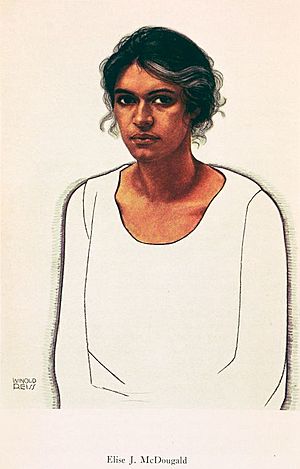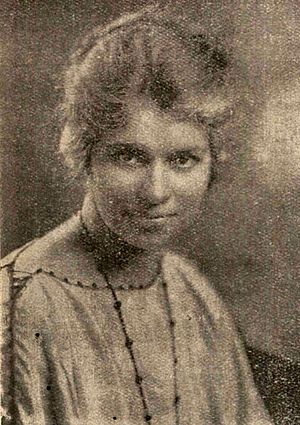Elise Johnson McDougald facts for kids
Elise Johnson McDougald (born October 13, 1885 – died June 10, 1971), also known as Gertrude Elise McDougald Ayer, was an important American educator, writer, and activist. She made history as the first African-American woman to become a school principal in New York City's public schools after the city became one big area in 1898. Before her, Sarah J. Garnet was the first African-American woman principal in Brooklyn, when Brooklyn was still a separate city.
One of McDougald's most famous writings was an essay called "The Double Task: The Struggle for Negro Women for Sex and Race Emancipation." It was published in March 1925 in a magazine called Survey Graphic. This special magazine issue, titled Harlem: The Mecca of the New Negro, was put together by Alain Locke. It helped to start and define a major cultural movement known as the Harlem Renaissance. McDougald's essay was a very early example of African-American feminist writing, which focuses on the rights and experiences of Black women.
Early Life and Education
Elise Johnson was born in New York City. Her father, Dr. Peter Augustus Johnson, was one of the first African-American doctors. He also helped start the National Urban League, an organization that works for civil rights and economic justice for African Americans.
Her mother, Mary Elizabeth Whittle, was from the Isle of Wight in England. Elise's older brother, Travis James Johnson, was the first African-American to graduate from Columbia University's College of Physicians and Surgeons in 1908. He was born in England in 1883, and their family moved to New York in 1884. Elise grew up in Manhattan but spent her summers on a "truck farm" (a farm that grows vegetables to sell) in New Jersey that her father's family owned. She later took over managing this farm.
In 1903, Elise Johnson became the first African-American to graduate from the Girls' Technical School. She was also chosen as the president of her senior class. After high school, she earned a teaching certificate from the New York Training School for Teachers. She took classes at Hunter College, Columbia University, and New York City College, but she never finished a bachelor's degree.
Career Highlights
Elise Johnson McDougald began her teaching career in 1905 at P.S. 11 in lower Manhattan. In 1911, she left her job to focus on her family. She returned to work in 1916 as a vocational counselor at the Manhattan Trade School. A vocational counselor helps people choose and prepare for careers.
She then worked as an industrial secretary for the local branch of the National Urban League. In this role, she started a study to look at the working conditions of African-American women in New York City. This study was supported by the Urban League, the Women's Trade Union League, and the YWCA. In 1919, she co-wrote a report called New Day for the Colored Woman in Industry in NY City with Jessie Clark. Her work also connected her with other important activists like W. E. B. Du Bois.
In March 1925, her important essay "The Double Task: The Struggle for Negro Women for Sex and Race Emancipation" was published. It appeared in the special Survey Graphic magazine issue about the Harlem Renaissance. This essay was also included in a later collection of writings called Daughters of Africa in 1992.
In 1935, McDougald was temporarily made principal of P.S. 24 during the Great Depression. This was a very hard time when many families had no jobs. More than 60% of families in her school's neighborhood were unemployed. Elise was part of a group of important New Yorkers who looked at the city's problems and suggested changes. She spoke at hearings, explaining how she wanted to build trust with parents, create a more relaxed school environment, and help struggling families.
Her activism led her to be one of the first people to create the "Activity Program." This program focused on teaching children in a new way, putting the child at the center of learning instead of just focusing on subjects. It included hands-on learning, projects where students chose what to do, and lessons that connected different subjects. The goal was to make classrooms feel more like "democratic living." After 10 years, she moved to P.S. 119. After she retired in 1954, she continued to be active. She wrote a column in the Amsterdam News newspaper about schools in Harlem.
Personal Life
Elise Johnson married twice. Her first husband was an attorney named Cornelius W. McDougald, but they later divorced. In 1928, she married her second husband, Dr. Vernon A. Ayer.
Elise Johnson McDougald passed away at her home on June 10, 1971, when she was 86 years old. She was survived by her second husband and her two children from her first marriage: Dr. Elizabeth McDougald and attorney Cornelius McDougald Jr.



